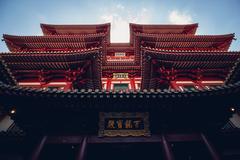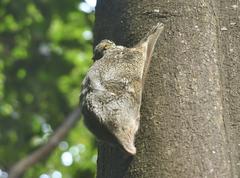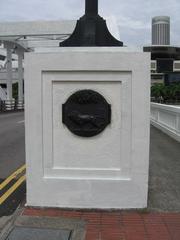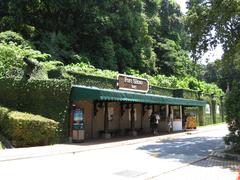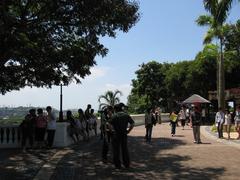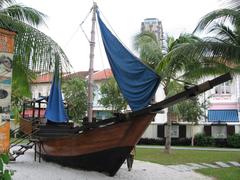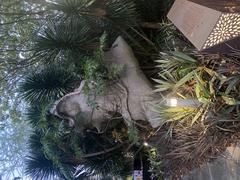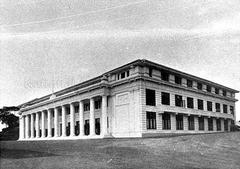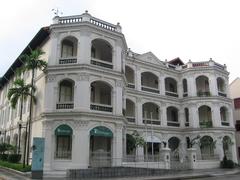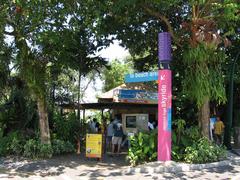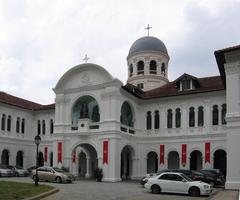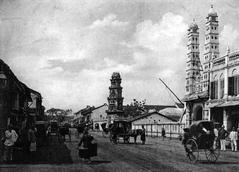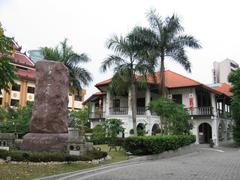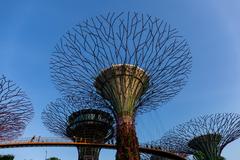Ci Ern Ge Shrine Singapore: Visiting Hours, Tickets & Comprehensive Visitor Guide
Date: 14/06/2025
Introduction
Ci Ern Ge Shrine (慈恩阁), also known as the Toa Payoh Tree Shrine, is a remarkable spiritual and cultural landmark nestled in the heart of Toa Payoh, one of Singapore’s oldest and most storied satellite towns. This living heritage site, centered around a once-mighty banyan tree, stands as a symbol of the area’s resilience, a bridge between Singapore’s kampong past and its vibrant urban present. The shrine’s unique history—rooted in local legends, community devotion, and the preservation of sacred natural spaces—offers visitors an intimate window into Singapore’s multicultural identity and enduring spiritual traditions.
This guide provides a detailed overview of Ci Ern Ge Shrine, including its historical evolution, visiting hours, accessibility, spiritual practices, and practical tips for visitors. Whether you are a heritage enthusiast, a spiritual seeker, or simply a curious traveler, this article will help you appreciate Ci Ern Ge’s significance and plan a respectful, enriching visit.
For further exploration, check out visual and narrative resources from official heritage sites and local travel platforms (Roots.gov.sg; SilverKris; TheSmartLocal).
Table of Contents
- Historical Background
- Visitor Information
- Spiritual Practices and Rituals
- Architectural and Artistic Features
- Nearby Attractions and Amenities
- Special Events and Festivals
- Frequently Asked Questions (FAQ)
- Conclusion and Call to Action
- References
Historical Background
Origins and Early History
The origins of Ci Ern Ge are intertwined with Toa Payoh’s transformation in the 1960s, when kampongs and villages gave way to Singapore’s first planned public housing estate. At the heart of the new town stood a majestic banyan tree. When redevelopment work began, repeated attempts to remove it failed—bulldozers malfunctioned, and construction halted inexplicably. These events sparked the belief that a powerful spirit resided within the tree, leading to the decision to protect it and establish a shrine at its base (Roots.gov.sg; SilverKris).
Religious Syncretism and Community Role
Initially dedicated to Na Tuk Kong (拿督公), a guardian spirit popular among Chinese communities, the shrine evolved to incorporate Taoist, Buddhist, and folk deities, including Guan Yin (观音, Goddess of Mercy), Tian Gong, and Tua Pek Kong. This religious syncretism reflects Singapore’s multicultural heritage, where diverse beliefs coexist and blend harmoniously. Over the decades, the shrine has become a vital community anchor, attracting worshippers who seek blessings for protection, good fortune, and health (Expat Choice; Evendo).
The Bulldozer Legend and Cultural Lore
The story of the “Bulldozer Tree” remains one of Singapore’s most enduring urban legends. Locals recount how bulldozers attempting to uproot the tree inexplicably broke down, and a bulldozer even overturned, reinforcing the belief in the tree’s spiritual power (TheSmartLocal; Thought Moments). Ultimately, developers left the tree standing, and the shrine became a testament to the community’s respect for the spiritual world.
Modern Preservation and Management
In 2013, a fierce storm damaged the original banyan tree, but the shrine persisted. The Singapore Toa Payoh Central Merchants’ Association, along with volunteers, undertook restoration efforts—reinforcing the tree, refurbishing the shrine, and improving accessibility. Today, Ci Ern Ge is meticulously maintained and remains a vibrant locus for spiritual and communal life (Expat Choice; Thought Moments).
Visitor Information
Visiting Hours and Admission
- Opening Hours: Daily, 7:00 AM – 9:00 PM (times may vary slightly; early morning or late afternoon visits are recommended for a quieter experience).
- Admission: Free of charge; donations are welcome to support shrine upkeep and charitable activities (Evendo).
Accessibility and Getting There
- Location: Block 177 Toa Payoh Central, Singapore 310177.
- By MRT: Alight at Toa Payoh MRT Station (North-South Line), Exit B. The shrine is a 5-minute walk away.
- By Bus: Multiple routes serve Toa Payoh Central; check Mapcarta for details.
- By Car: Public car parks are nearby, though space is limited during peak hours.
- Accessibility: The shrine is wheelchair accessible, with ramps and smooth pathways.
Etiquette and Dress Code
- Dress modestly, covering shoulders and knees.
- Remove shoes before entering the altar area.
- Speak softly; maintain a respectful demeanor.
- Refrain from loud conversation, eating, or smoking within shrine grounds.
Photography and Practical Tips
- Photography is allowed in outdoor areas; always ask for permission before photographing inside the shrine or when worshippers are present.
- The best lighting for photos is during early morning or late afternoon.
- Carry an umbrella or sun protection due to Singapore’s tropical climate.
- Cash is preferred at nearby stalls and for donations (Lonely Planet).
Spiritual Practices and Rituals
Ci Ern Ge is an active place of worship where devotees offer incense, fruits, and flowers to the deities. Rituals are most vibrant during Chinese festivals such as Lunar New Year and the Hungry Ghost Festival, when the shrine is decked with lanterns and banners. Visitors are welcome to observe or respectfully participate in simple acts, such as lighting incense or bowing at the altar (Evendo).
Architectural and Artistic Features
The shrine’s structure is modest yet evocative, featuring traditional Chinese design elements such as red pillars, tiled roofs, and gold details. The altar at the heart of the pavilion is adorned with statues of Guan Yin and other deities, surrounded by offerings and calligraphic plaques. The remains of the original banyan tree, decorated with prayer ribbons and lanterns, underscore the ongoing connection between nature and spirituality (SilverKris).
The peaceful gardens and shaded seating areas further contribute to the shrine’s tranquil atmosphere, providing a serene retreat from city life.
Nearby Attractions and Amenities
- Toa Payoh HDB Hub: A bustling complex with shops, food courts, and community services.
- Toa Payoh Public Library: A modern library offering insight into local life.
- Town Park and Heritage Trail: Green spaces and self-guided heritage walks.
- Balestier Road: Famous for heritage shophouses and local cuisine.
For refreshments, explore nearby hawker centres. Small bills ($2, $5, $10) are usually preferred at food stalls (Lonely Planet).
Special Events and Festivals
Ci Ern Ge comes alive during major Chinese festivals and community events. The site is decorated elaborately, and rituals draw larger crowds. While these periods provide a vibrant cultural experience, visitors should be mindful of increased foot traffic and possible restrictions on photography or access.
Frequently Asked Questions (FAQ)
Q: What are Ci Ern Ge’s visiting hours?
A: The shrine is open daily from 7:00 AM to 9:00 PM.
Q: Is there an entrance fee or need for tickets?
A: No, the shrine is free to enter and open to all.
Q: How do I get to the shrine?
A: It’s a short walk from Toa Payoh MRT Station (North-South Line). Multiple bus routes serve the area.
Q: Is the shrine wheelchair accessible?
A: Yes, there are ramps and smooth pathways for wheelchair users.
Q: Can visitors participate in rituals?
A: Visitors may observe or respectfully join in offering incense or prayers.
Q: Is photography allowed?
A: Permitted in outdoor areas; ask for consent before photographing inside or during rituals.
Q: Are guided tours available?
A: While there are no regular tours at the shrine, it is featured in some Toa Payoh heritage trails and community tours.
Conclusion and Call to Action
Ci Ern Ge Shrine is a living testament to Singapore’s ability to balance rapid urbanization with the preservation of spiritual and cultural heritage. Its enduring presence, from the legendary banyan tree to its role as a community hub, makes it a must-visit for anyone seeking authentic insights into Singaporean life and tradition. With free admission, convenient access, and a welcoming atmosphere, the shrine offers a peaceful, meaningful stop on any exploration of Singapore’s historical sites.
Plan your visit to Ci Ern Ge and engage with Singapore’s vibrant heritage. For more travel guides, heritage trails, and insider tips, download the Audiala app and follow us on social media. Discover, respect, and celebrate the unique legacy of the Toa Payoh Tree Shrine.
References
- Tree Shrine at Block 177, Toa Payoh Heritage Trail – Roots.gov.sg
- Hidden Gems of Toa Payoh – SilverKris
- Sights in Toa Payoh – TheSmartLocal
- The God Tree in Toa Payoh – Thought Moments
- Singaporeans Praying to Trees – Rice Media
- Ci Ern Ge Shrine Overview – Evendo
- Story of the Mighty Banyan Tree – Expat Choice
- Ci Ern Ge Shrine Location – Mapcarta
- Things to Know Before Traveling to Singapore – Lonely Planet



